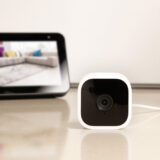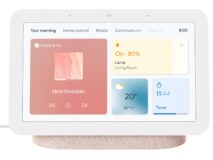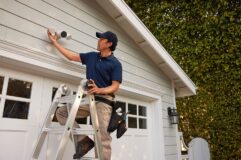
Homeowners with a Smart Home who are moving need to plan how their new home will become equally smart as their old home or perhaps even more smart. Moving seems like a huge undertaking, but it doesn’t have to be. This article provides many tips and tricks home buyers need for a smart move. I’ll start by discussion how a smart home can help homeowners sell their home. Then we’ll look at how homeowners can protect their belongings throughout the moving process with smart cameras and smart doorbells. Finally, we’ll discuss how a move is the perfect opportunity to build a new smart home from scratch.
Selling your smart home
If a homeowner has already created a smart home, it can help sell their home. People like realtors and prospective buyers will be coming and going. Furthermore, homeowners might not be home when they come or they might not want them there. Still, how do homeowners let strangers come into their house? Let’s examine the benefits of a smart home during the selling phase.
Granting remote access for viewings
One of the main benefits of Smart Locks is granting remote access. For example, if a homeowner is at work and a contractor is coming to do repairs, they can simply use their smartphone to unlock the door. This can be particularly useful before someone lists their home. Cleaners, inspectors and photographers are likely coming and going.
Smart locks also offer other features that enhance security and convenience. For example, many models allow the creation of virtual keys or access codes that can be sent to others via email or text message. This eliminates the need to give physical keys to a relator. Some smart locks also come with built-in cameras or sensors that can detect when someone is at the door and sends a smartphone notification. This keeps homeowners informed who is coming and going during the selling process.
Monitoring open houses
The thought of having strangers walking around a home during viewings may seem daunting. With smart security cameras, monitor open houses remotely. Discreetly place indoor security cameras in areas where people should not be venturing in.
For example, if a homeowner has valuables stored in their closet, install a camera there. If someone tries to steal during an open house, there will be footage of the theft. Furthermore, most smart security cameras have motion detection. This ensures homeowners can watch them in real time and have the video uploaded to the cloud.
Setting a mood for open houses
It’s often said that people decide if they like a house within 30 seconds of entering. During open houses, smart speakers and smart lights add ambiance and flair. If homeowners have multiple smart speakers, group them together and have music play in the background. As people move room to room, it will feel like the music is following them. Don’t forget to put a smart speaker in the bathroom. That will be sure to impress prospective buyers who use the bathroom.
Staging rooms becomes much easier with smart lights. Use them to add colour and accents to walls, under couches, and on top of cabinets. Create a feel by combining different colours to add character to rooms and space. Background music and lights can enhance the feel of a home without people even noticing it.
Building a smart home from scratch
Moving into a new space is the perfect time to set up a smart home. Use your existing equipment and add more as required or desired. The first step is setting up a new home Wi-Fi networking. This networking buying guide is a great place to decide which Wi-Fi system is right for a new space. Once homeowners have a new Wi-Fi network, they can get started on building a new smart home.
Setting up a smart home hub
At the core of any smart home is an ecosystem. Google, Amazon, and Apple all provide smart home ecosystems. A good tip is to install the main smart speaker or smart display in the kitchen. This is where people will likely use it the most. From here, add additional smart speakers to bedrooms and bathrooms. The key is to stick to one ecosystem and build off it.
Retrofitting lights with smart lights
Before moving in, take a close look at the indoor lighting in a new home. If the light fixtures use standard light bulbs, consider upgrading all the lights with multi-color smart lights. Simply screw them into any standard light socket, and set each light up on an app. From there, group lights together, and turn them off and on with voice commands. Set schedules in the app to automatically turn lights off at night.
Setting up smart security cameras
After a homeowners move in, the next step is securing the home and protecting their family. Use smart security cameras outdoors to monitor activity at night. If motion is detected, these cameras will provide push notification and record activity to the cloud. If someone is not home, they can remotely view the cameras in real-time.
Some smart security cameras feature built-in LED flood lights. This also acts to deter thieves from entering your property. Ring, Arlo, and Blink are some of the popular home security cameras brands to consider.
Upgrading to smart thermostats
Moving is the perfect time to upgrade a home’s heating system with a smart thermostat. There are smart thermostats for every type of heating system including central heating and baseboard heating. If a home has a single central thermostat, homeowners need only one smart thermostat. Baseboard heating is zoned heating with a dedicated thermostats for each baseboard. In that case, they will need multiple thermostat for each room.
Many smart thermostats feature AI and automation to study a home’s heating habits. This smart thermostat buying guide will help you find the right one for you.
Here are my quick “Smart Home” moving tips :
- Collect free boxes ones from liquor and grocery stores.
- Find where the Internet line comes into the home. Use that to plan the location of your modem and router.
- Use masking tape to label cables before you unplug them. Take pictures of the back of all devices so you know how to reconnect them
- Install smart home devices like thermostats, lights, and smart locks before you move in.
- Wipe electronics down with a dry cloth before packing into boxes for the move.
- List people and businesses regularly sending you mail to notify them of your impending address change
- Purge old stuff. Bring old electronics to recycling depots during the packing stage
Moving in and out of a smart home
Moving is an exciting time for anyone. A smart home can help sell a home and monitor it remotely during open houses. Moving into a new place is the perfect time to build a smart home from scratch. To get started, read this smart home buying guide. This will help people decide which smart home products they need from Best Buy.









